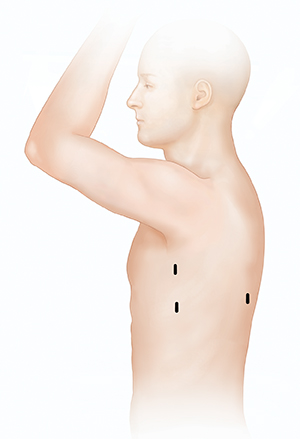Thoracoscopy
Thoracoscopy
Thoracoscopy is also called video-assisted thoracoscopy surgery (VATS). It’s often used to repair a collapsed lung. It’s also used to look at, biopsy, and stage a mass in the lung. Or it may be needed to drain fluid from around the lungs. An entire lobe or entire lung can be removed during this surgery. During this surgery, your surgeon can look into your chest. He or she will then do procedures through small incisions in the chest wall. Sometimes a thoracoscopy can’t be used for the whole surgery. In this case, you may need an open surgery (thoracotomy).
Preparing for your surgery
Ask any questions you have about the surgery.
Have blood tests or other tests that your doctor orders.
If you smoke, stop right away.
Tell your doctor about any medicines you’re taking. This includes aspirin. Ask if you should stop any of them. Mention any vitamins, herbs, or other supplements you take.
Don’t eat or drink anything after midnight the night before your surgery, or as directed.
Arrive at the hospital on time the day of your surgery.
The surgery
The anesthesiologist gives you general anesthesia. This lets you sleep and keeps you free from pain during surgery. Once you’re asleep, you’ll be moved to lie on your side.
The surgeon will make several small incisions in your side.
The surgeon puts a thin tube (catheter) through one of the incisions. It contains a tiny camera. This camera allows the surgeon to view your lungs on a video monitor. The surgeon puts surgical tools through the other incisions.
When the procedure is done, the surgeon may put one or more tubes in your chest temporarily. These drain fluid and air. The incisions are then closed with sutures or staples.
Risks and complications
VATS is generally safe. But like any surgery, it has a small risk of complications. Complications could include:
Wound infection
Air leak through the lung wall. This requires a longer hospital stay or another operation.
Bleeding
Pain or numbness at the incision site
Bruising of the nerves under the ribs (intercostal nerve syndrome). This causes pain at the incision site for several weeks or months.
Lung infection (pneumonia)
The surgery cannot be completed as planned and a large incision is used
Updated:
August 07, 2018
Sources:
An overview of medical thoracoscopy. UpToDate., Overview of Video Assisted Thoracoscopic Surgery (VATS), UpToDate
Reviewed By:
Fetterman, Anne, RN, BSN,Image reviewed by StayWell medical illustration team.,Mancini, Mary C, MD
